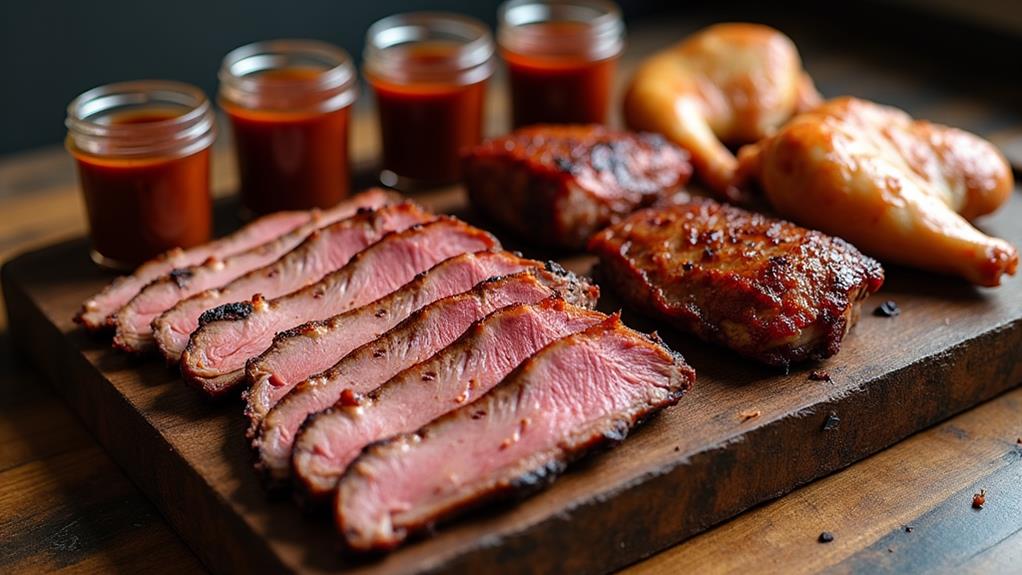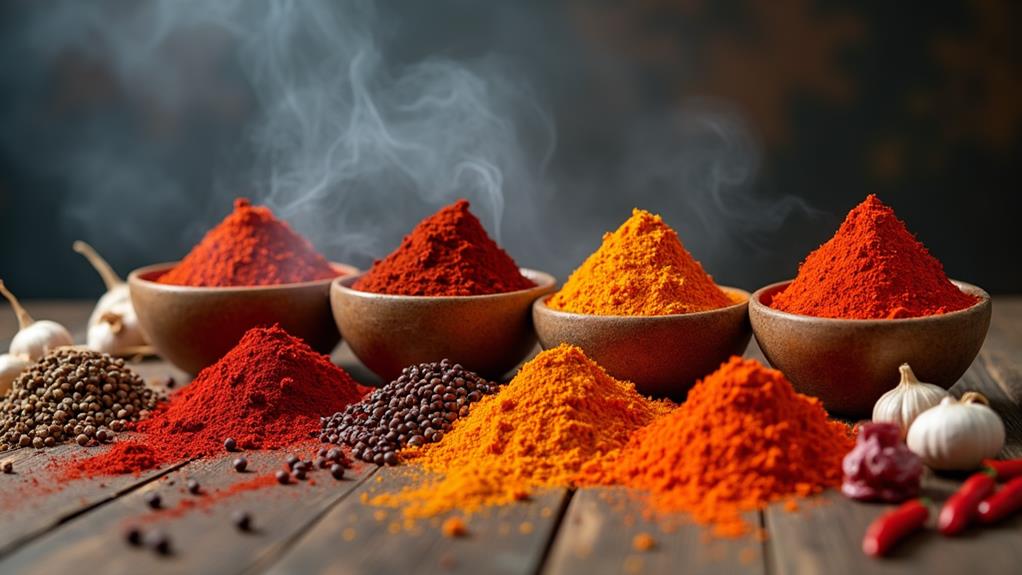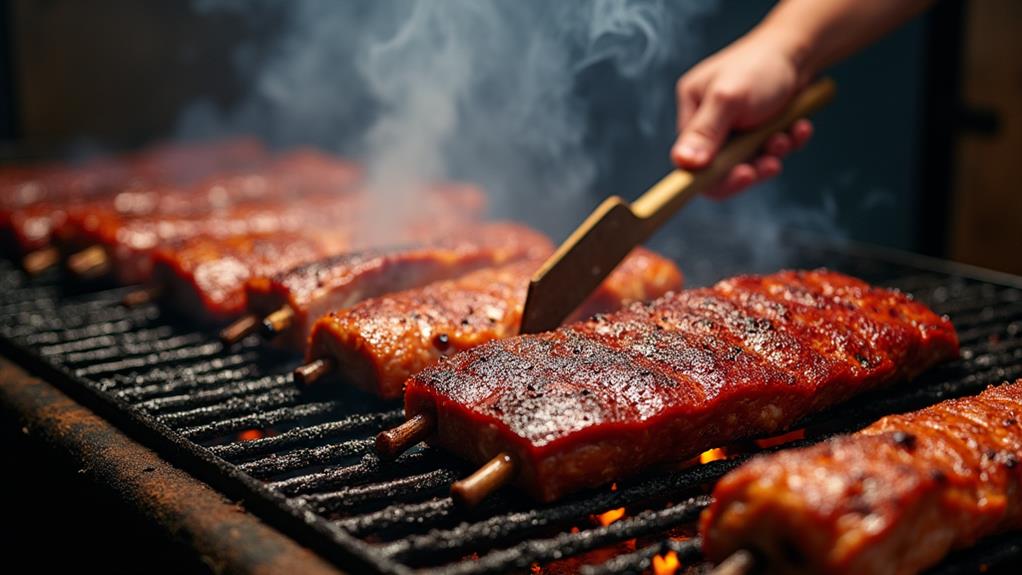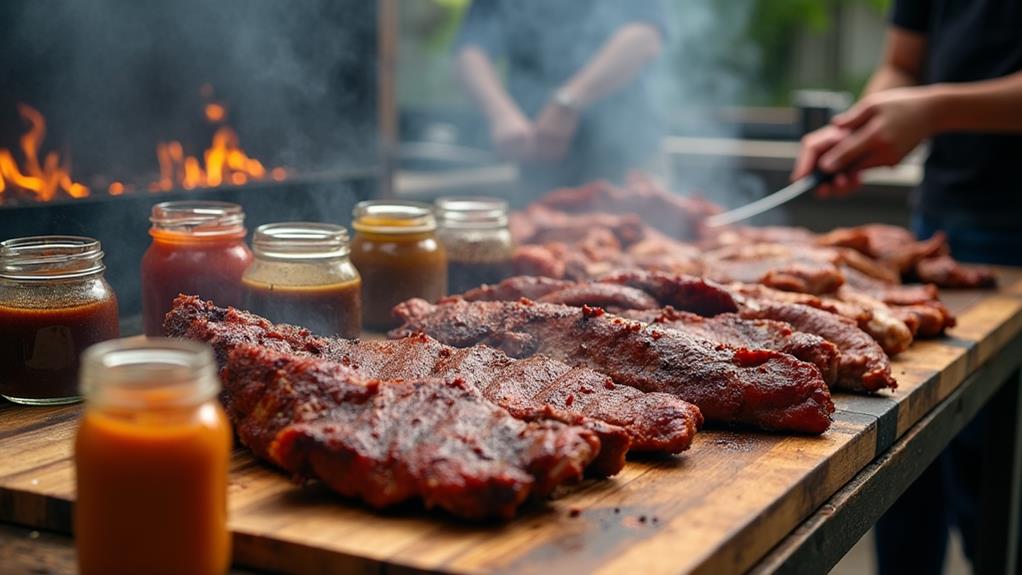American barbecue traditions offer a rich tapestry of flavors and techniques that vary widely across regions. You'll discover tangy vinegar-based sauces in the Carolinas, sweet tomato sauces in Kansas City, and spicy pepper sauces in Texas. Each area has its preferred meats, from Texas brisket to North Carolina pulled pork. Smoking and grilling methods differ too, with some regions favoring slow and low cooking while others opt for hot and fast techniques. Signature spice blends and wood selections further define local styles. As you explore these regional differences, you'll uncover the saucy secrets that make American barbecue a diverse and beloved culinary art form.
The Roots of American Barbecue
Tracing the roots of American barbecue takes us on a journey through time and cultural influences.
You'll discover a rich tapestry of flavors and techniques that have evolved over centuries. The historical evolution of barbecue in America began with indigenous cooking methods, which were then blended with European and African traditions.
As you explore this culinary heritage, you'll find that barbecue's origins lie in slow-cooking techniques used by native tribes. These methods were adapted by early settlers and enslaved Africans, who incorporated their own spices and cooking styles.
The result was a unique fusion of flavors that varied by region.
In the South, you'll notice distinct barbecue styles emerging, each with its own signature sauces and cooking methods. From the vinegar-based sauces of North Carolina to the tomato-rich concoctions of Kansas City, these regional variations reflect the cultural influences that shaped them.
Understanding the roots of American barbecue will help you appreciate the innovation and creativity that continues to drive this beloved culinary tradition forward.
Regional Sauces That Define Flavor
Regional sauces are the heart and soul of American barbecue, each offering a unique flavor profile that reflects local tastes and traditions.
As you explore the diverse world of barbecue, you'll discover that sauce pairings can make or break your culinary experience. In the Carolinas, you'll encounter a tangy, vinegar-based sauce that cuts through rich pork flavors. Move west to Kansas City, and you'll find a thick, sweet tomato-based sauce that clings to ribs and brisket. Texas favors a spicy, pepper-forward sauce that complements its famous beef barbecue. Alabama's unique white sauce, made with mayonnaise and vinegar, is perfect for smoked chicken.
To truly appreciate these regional differences, experiment with various sauce pairings. Try a mustard-based South Carolina sauce on pulled pork, or a smoky Memphis-style sauce on dry-rubbed ribs. Don't be afraid to mix and match; you might discover a new favorite combination.
Preferred Meats Across the States

As you explore American barbecue, you'll notice that meat preferences vary significantly across different regions of the United States.
From Texas's famous beef brisket to North Carolina's pulled pork, each area has its own quintessential barbecue meat that locals swear by.
You'll also encounter some unique local favorites, such as Kentucky's mutton barbecue or Hawaii's Kalua pork, which add diversity to the American barbecue landscape.
Regional Meat Preferences
American barbecue enthusiasts often zero in on their favorite regional meats when firing up the grill. You'll find that meat cuts vary significantly across the country, influenced by local cultural traditions and flavor profiles.
In the South, you're likely to encounter pork as the star of the show, with ribs and pulled pork taking center stage. Head to Texas, and you'll discover a love affair with beef brisket, slow-cooked to perfection. The Midwest often favors a mix of beef and pork, while the Northeast might surprise you with its focus on poultry and seafood.
These regional variations aren't just about tradition; they're deeply rooted in local sourcing practices and seasonal preferences. You'll notice that preparation methods differ too, with some regions favoring dry rubs while others swear by wet marinades.
To truly innovate in your grilling game, explore these regional differences and experiment with new techniques. Try incorporating unique meat cuts from different areas or adapting preparation methods to suit your local ingredients.
Unique Local Favorites
Building on these regional preferences, you'll find an array of unique local favorites across the United States. These local specialties often reflect the cultural influences and historical backgrounds of their respective regions.
As you explore the country's barbecue landscape, you'll encounter dishes that might surprise and delight your taste buds.
Some standout local favorites include:
- Alabama's white barbecue sauce, a tangy mayo-based concoction
- Kentucky's mutton barbecue, showcasing slow-cooked lamb
- St. Louis' crispy snoots, made from pig snouts
- Hawaii's kalua pork, traditionally cooked in an underground oven
These distinctive dishes demonstrate the innovation and creativity in American barbecue.
You'll notice how each region adapts traditional techniques to local ingredients and tastes. For example, coastal areas might incorporate seafood into their barbecue repertoire, while inland regions may focus on game meats.
As you explore these unique local favorites, you'll gain a deeper appreciation for the diversity of American barbecue.
Don't be afraid to step out of your comfort zone and try these regional specialties – you might discover a new favorite that challenges your preconceptions about barbecue.
Smoking and Grilling Techniques
When you're ready to master smoking and grilling techniques, you'll need to understand the difference between direct and indirect heat methods, which can dramatically affect your barbecue results.
The wood you select for smoking plays a crucial role in flavor development, so it's important to choose wisely based on the meat you're preparing and the taste profile you're aiming for.
To achieve barbecue perfection, you'll need to develop a keen sense of temperature control, maintaining consistent heat levels throughout the cooking process for optimal tenderness and flavor.
Direct vs. Indirect Heat
The art of barbecue hinges on mastering two fundamental cooking methods: direct and indirect heat. Understanding these techniques is crucial for achieving the perfect balance of flavor and texture in your grilled or smoked meats.
Direct heat cooking involves placing food directly over the heat source, ideal for searing and quick-cooking items. Indirect heat, on the other hand, utilizes flame management and strategic heat distribution to cook food more slowly and evenly.
To elevate your barbecue game, consider these innovative approaches:
- Experiment with dual-zone cooking, combining direct and indirect heat zones
- Use heat deflectors to create more even temperature distribution
- Implement reverse searing for thick cuts of meat
- Utilize multi-level grates for precise temperature control
When using direct heat, you'll need to manage your flames carefully to prevent flare-ups and ensure consistent cooking.
For indirect heat, focus on maintaining a steady temperature throughout the cooking process. By mastering both methods, you'll be able to tackle a wide range of barbecue dishes with confidence, from quick-seared steaks to slow-smoked briskets.
Wood Selection Matters
Choosing the right wood for smoking and grilling can make or break your barbecue experience. The wood types you select will significantly impact the flavor profiles of your meats, so it's crucial to understand their unique characteristics. Different woods contribute distinct aromas and tastes, ranging from the sweet and mild notes of cherry to the robust and intense flavors of hickory.
Consider regional preferences when selecting your wood. In the South, you'll often find pitmasters using hickory or mesquite, while fruit woods like apple and peach are popular in other areas.
Smoking times vary depending on the wood's density, so adjust accordingly. For longer cooks, hardwoods like oak are ideal, while softer woods like alder work well for shorter smoking sessions.
As you explore wood selection, don't overlook sustainability practices. Seek out responsibly sourced woods and consider charcoal alternatives made from renewable resources.
Temperature Control Mastery
Mastering temperature control stands as the cornerstone of successful barbecue. You'll need to understand the interplay of pit temperature, ambient temperature, and thermal dynamics to achieve that perfect smoke ring and tender meat.
Start by investing in reliable temperature probes to monitor your cooking environment accurately. Remember, heat distribution isn't uniform, so place probes strategically to get a comprehensive picture.
To elevate your barbecue game, focus on these key aspects:
- Fire management: Learn to control your heat source for consistent cooking
- Heat retention: Properly insulate your smoker to maintain steady temperatures
- Moisture control: Use water pans to regulate humidity and prevent drying
- Cooking times: Adjust based on meat size, desired doneness, and temperature fluctuations
Understanding heat flow in your pit is crucial. Hot spots can lead to uneven cooking, so rotate your meats as needed.
Pay attention to smoke quality; thin blue smoke indicates ideal conditions. As you practice, you'll develop an intuitive sense of your pit's behavior, allowing you to anticipate and adapt to changes in ambient temperature.
This mastery of temperature control will significantly improve your barbecue results, ensuring consistently delicious outcomes.
Signature Spice Blends and Rubs

At the heart of American barbecue lies the art of seasoning, with signature spice blends and rubs playing a crucial role. You'll find that mastering these flavor enhancers can elevate your barbecue game to new heights.
Rub innovation has become a hallmark of modern pit masters, who strive to create unique flavor profiles that set their meats apart. When crafting your own signature blends, focus on achieving a perfect flavor balance.
Consider the spice origins and regional variations that influence traditional recipes. For example, Texas-style rubs often lean heavily on black pepper, while Memphis blends might incorporate more paprika.
Experiment with different rub applications, such as dry brining or creating a wet rub paste. Ingredient sourcing is crucial for developing standout flavors. Seek out high-quality, fresh spices from reputable suppliers.
Don't be afraid to mix unexpected elements, like coffee grounds or cocoa powder, for depth and complexity. As you perfect your blend, remember that the best pit masters guard their secret recipes closely.
Keep detailed notes on your experiments to refine your signature spice mix over time.
Wood Selection for Optimal Flavor
With wood selection, you're embarking on a crucial aspect of barbecue flavor development. The type of wood you choose can make or break your smoky masterpiece.
Hickory benefits include a robust, bacon-like flavor that complements pork and beef beautifully. Mesquite flavor, on the other hand, offers a strong, earthy taste that's perfect for bold meats like brisket.
To elevate your barbecue game, consider these innovative wood-selection strategies:
- Experiment with fruit woods like apple or cherry for a subtle sweetness
- Blend different wood types to create unique flavor profiles
- Use wood pellets for consistent smoke in electric smokers
- Try exotic woods like olive or grapevine for a gourmet twist
Unique Preparation Methods by Region

Every region in America boasts its own unique barbecue preparation methods, reflecting local traditions and flavors. As you explore these regional techniques, you'll discover a rich tapestry of smoking styles, grilling traditions, and marinade techniques that have evolved over generations.
In the South, you'll find slow-smoking methods using hickory or oak, often paired with vinegar-based sauces in the Carolinas or sweet, tomato-based sauces in Kansas City.
The Midwest embraces a "hot and fast" approach, with direct grilling over high heat. Texas barbecue, influenced by German and Czech settlers, focuses on beef brisket smoked over post oak.
Regional spices play a crucial role in flavor profiles, from the paprika-heavy rubs of Memphis to the garlic and chili-infused marinades of California.
Cooking vessels vary too, from traditional pit barbecues to modern offset smokers. Fire management techniques differ, with some regions favoring long, slow burns while others opt for intense, quick cooks.
Cultural influences shape serving styles, from the pulled pork sandwiches of the Southeast to the burnt ends of Kansas City.
These diverse methods culminate in outdoor gatherings that celebrate each region's unique barbecue heritage.
Frequently Asked Questions
Is Barbecue Sauce Always Necessary for Authentic American Barbecue?
You'll find that barbecue sauce isn't always necessary for authentic American barbecue. Its significance varies with regional traditions. Embrace innovation by exploring dry rubs, marinades, and alternative flavor profiles to elevate your barbecue game beyond traditional sauces.
How Do Vegetarian Options Fit Into Traditional Barbecue Culture?
Picture this: a smoky paradise where veggies sizzle alongside meats. You'll find vegetarian adaptations blooming in barbecue culture. Innovative pitmasters are embracing plant-based proteins and flavor alternatives, proving that the grill's not just for carnivores anymore. Explore these exciting new frontiers!
What Are the Health Implications of Regularly Consuming Barbecue?
You'll face health risks like increased cancer risk and heart disease from regularly eating barbecue. However, you'll also gain nutritional benefits from protein-rich meats. Balance is key. Innovate by exploring healthier grilling techniques and lean protein options.
How Has Barbecue Influenced American Politics and Social Gatherings?
Where there's smoke, there's fire! You'll find barbecue's influence at political rallies and community gatherings. It's become a catalyst for innovation in American social dynamics, fostering connections and sparking discussions across party lines and neighborhoods.
Are There Any Endangered Barbecue Traditions at Risk of Disappearing?
You'll find some regional variations of barbecue are at risk. As tastes evolve, you're seeing traditional methods fade. But don't worry – cultural preservation efforts are keeping these endangered traditions alive. You can help by exploring and supporting local BBQ joints.
Final Thoughts
You've now journeyed through the saucy tapestry of American barbecue, uncovering regional secrets that'll make your taste buds dance for joy. From the tangy vinegar-based sauces of the Carolinas to the sweet, thick glazes of Kansas City, you've explored a world of flavors. Armed with knowledge of smoking techniques, spice blends, and wood selection, you're ready to embark on your own barbecue adventure. Remember, great barbecue isn't just cooked; it's crafted with passion and time-honored tradition.















